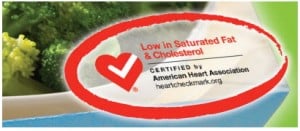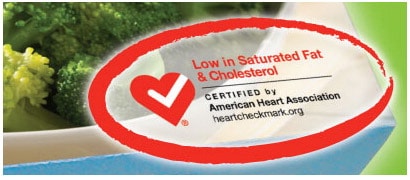
What do I mean? I mean that we see labels that say things like “made with whole grain!!!” or “heart healthy!!!” or “endorsed by the American Healthy Foods of America American Association!!!” or “Natural!!!!” or “Organic!!!!!!” and automatically assume that the product promotes health, wellness and weight loss.
The “halo effect” is where we assume that just because a product comes with a certain phrase on the label – or comes from a certain store – that it’s going to further our goals.
Trust me. It’s not. Consider this from the New York Times a few years back:
Our collaboration began in a nutritionally correct neighborhood, Brooklyn’s Park Slope, whose celebrated food co-op has a mission statement to sell “organic, minimally processed and healthful foods.” I hit the streets with two questionnaires designed by Dr. Chandon, a professor of marketing at the Insead business school in Fontainebleau, France, and Alexander Chernev, a professor of marketing at Northwestern University. Half of the 40 people surveyed were shown pictures of a meal consisting of an Applebee’s Oriental Chicken Salad and a 20-ounce cup of regular Pepsi. (You can see it for yourself at TierneyLab.) On average, they estimated that the meal contained 1,011 calories, which was a little high. The meal actually contained 934 calories — 714 from the salad and 220 from the drink.
The other half of the Park Slopers were shown the same salad and drink plus two Fortt’s crackers prominently labeled “Trans Fat Free.” The crackers added 100 calories to the meal, bringing it to 1,034 calories, but their presence skewed people’s estimates in the opposite direction. The average estimate for the whole meal was only 835 calories — 199 calories less than the actual calorie count, and 176 calories less than the average estimate by the other group for the same meal without crackers.
Just as Dr. Chandon had predicted, the trans-fat-free label on the crackers seemed to imbue them with a health halo that magically subtracted calories from the rest of the meal. And we got an idea of the source of this halo after I tried the same experiment with tourists in Times Square.
These tourists, many of them foreigners (they kept apologizing for not knowing what Applebee’s was), correctly estimated that the meal with crackers had more calories than the meal without crackers. They didn’t see the crackers’ health halo, Dr. Chandon said, presumably because they hadn’t been exposed to the public debate that accompanied New York City’s decision last year to ban trans fat from restaurants.
“It makes sense that New Yorkers would be more biased because of all the fuss in the city about trans fat,” Dr. Chandon told me. “It hasn’t been a big issue in most other places. Here in Europe there’s been virtually no discussion of banning trans fats.”
[…]
The researchers found that customers at McDonald’s were more accurate at estimating the calories in their meal than were customers at Subway, apparently because of the health halo created by advertisements like one showing that a Subway sandwich had a third the fat of a Big Mac. The health halo from Subway also affected what else people chose to eat, Dr. Chandon and Dr. Wansink reported last year after giving people a chance to order either a Big Mac or a 12-inch Italian sandwich from Subway. Even though the Subway sandwich had more calories than the Big Mac, the people ordering it were more likely to add a large nondiet soda and cookies to the order. So while they may have felt virtuous, they ended up with meals averaging 56 percent more calories than the meals ordered from McDonald’s.
“People who eat at McDonald’s know their sins,” Dr. Chandon said, “but people at Subway think that a 1,000-calorie sandwich has only 500 calories.” His advice is not for people to avoid Subway or low-fat snacks, but to take health halos into account.
This also applies to groceries. You will find some kind of strange affirmative labeling on the front of any and every product-you-know-you-have-no-business-buying, because the goal is to get you to realize “See? Maybe I’m just being silly. This product DOES have redeeming qualities! Let me go ahead and get these benefits!” We just fail to realize that it really doesn’t work that way.
Below, I’ll explain five ways we allow “the halo effect” to swindle us, and how we can avoid the pitfalls as needed.
- “Made With Whole Grain!” – Usually found on the top of your favorite cereal box, the “made with whole grain” label basically lets you know that the product was created with whole grain. That means… there’s whole grain in there. It doesn’t mean there’s ONLY whole grain in there. It certainly doesn’t mean there’s no chemicals in there. It just means you will get some whole grains.This is a swindle because it implies that you can’t get your whole grains elsewhere, and therefore NEED to get them from this product. “Are you trying to get in more whole grains! Buy ME!” Don’t. Whole grains can be acquired via couscous, quinoa, various forms of rice, oatmeal, spelt, millet, cornmeal… the possibilities are endless. Please don’t get suckered into buying a chemical-laden product out of fear that you’re “not getting enough whole grains.” Grab some oatmeal and get cookin’ if you’re that worried.
- “Heart Healthy!” – The American Heart Association – who I’m sure has no ill intentions – and their big bright label is a great example of a “health halo.” A product may have minimal trans-fat (not none, just minimal), minimal salt and minimal fat (which is questionable, but more on that later)… but there’s still chemicals in it. There’s nothing to be said of sodium nitrate (food preservative and rocket fuel.. how versatile!) or monosodium glutamate (quoting the FDA: “we don’t know how it works, but we think it’s safe) or goodness knows what else. Do you see a pattern forming?
- “Endorsed by [insert organization]!” – I see this a lot at restaurants: They’ll have a “[insert organization] approved menu” full of items that meet certain qualifications – things like, “Very low carb meal!” or “Meets our standards!” – but what about the rest? What about the sugar levels? What about the quality of the ingredients? Why are we still saying “low-fat is the way to go” when, after three decades of “low fat” being shoved down our throats, we’re even fatter than before? Maybe these organizations doing the endorsing need their own health halos removed.
- “All natural!” – To quote my own words:
The word “natural” means a lot of things. Unfortunately for us, none of them mean the same thing. Clever marketing allows us to think that “natural” means the same as “organic” – pictures of farms, gardens, farmers and cows serve as the backdrop to a bright little starburst in the corner saying “All natural!” It makes you think “organic,” but it’s not. This is to the marketer’s benefit, because they get all the benefits of looking “organic” without all the hoops they’d have to jump through to be “organic.” For crying out loud, high fructose corn syrup can be considered “natural.” [source]
Basically, natural doesn’t mean much.
- “Organic!” – Before I’m tarred and feathered, let me be clear: I’m not talking about organic fruits and veggies. I’m talking about processed foods that carry the “organic” labeling. All the labeling means is that it was, at the very least, made with at least 70% organic products. Organic junk food exists. Organic food with empty calories… exists. Organic is not a free pass for “healthy.” From the Wall Street Journal:
The latest research, a study by University of Michigan researchers to be published in the journal Judgment and Decision Making, is on organic foods. The study found that participants who looked at the nutrition facts label (which includes the calorie count) for Oreos “made with organic flour and sugar” were more likely to rate the cookies as lower-than-average in calories than were people looking at the label of conventional Oreos. “Presumably, participants inferred that, if organic cookies contain 160 calories, then the calorie content of conventional cookies — whatever the precise amount — is likely to be higher,” the authors write.
And, the people looking at the organic cookie label were also more likely to say their cookies were appropriate to eat more often.
In a separate, but related experiment, participants were more likely to say it was okay for a hypothetical 20-year-old trying to lose weight to skip her evening run if her dinner ended with an organic dessert rather than a conventional, but otherwise identical one.
Wish y’all could see my face right now. For real?
- Bonus: “This is okay, I got it from [insert ritzy-glitzy-healthy-conscious-store]!” – Don’t be mad, because I shop at these ritzy-glitzy-crunch-granola stores, too. However… I don’t allow myself to be glamored into thinking everything available there is healthy. Those stores have a market to sell to, and needs to fulfill, as well. I can find the same super-long-junk-food aisles in my crunchy-granola-healthy-food-only-store as I can at my regular run of the mill neighborhood grocery chain. No store is oblivious to the needs of the public, and since they know the public wants their sugar/fat/salt combo… that store is going to provide it. Period. They’ve got money to make.
The reality is that health halos – and their subsequent pretty labeling – serve as green lights for many of us who are apprehensive about certain dishes (usually with good purposes). They’re put there to give us an appropriate reason to bypass our apprehension and dive in. Those of us who might not eat at Applebee’s might be more convinced to dine there because “they’ve got a Weight Watcher’s menu!” Those of us who don’t do cereals might be more convinced to buy one because “I can get in my whole grains!”
If I don’t want it, if I believe I shouldn’t eat it… don’t. It’s that simple. Sound decision making comes from educating myself on my options, and choosing what I consider to be the best from my set of options…. and not letting pretty colors or labeling or nice phrasing get in my way.


7 comments
Hi Erika,
I just love your blog. Great work.
Thank you! 🙂
I’ve been poking around on this site for a few days now, and it just occurred to me how much research you do.
That’s amazing.
Let me tell you…. When I left NYC and moved to NJ, I gained about 35#. One reason? No calorie labels on food. NYC has a law mandating eateries put calorie counts on their food. When I’m in NYC, I always make better choices because its in my face. Without thinking, I chose whatever. Sometimes, we are deceived by certain bits of information but in the last few months, I’ve gotten way better at reading labels and not guestimating. I’m pretty accurate with stuff.
So true. I am a label reader thanks to you on the turkey bacon article it was an eye opener to so many products.
Just a note there is an organic oatmeal cookie that I use to eat that had fresh ingredients, lots of fiber, healthy.
Yet that cookie one of that cookie was almost 300 calories. I skipped that and had a handful of nuts (almonds, walnuts, pecans) for 150 calories or less as a snack.
I never thought of it that way but that’s a good way of putting it. Because I used to buy those products all the time, even though I had a feeling I should have read the label first. I’ve been steadily learning what to do while grocery shopping, no matter how long it takes or how frustrating it is. They try to pull you in with those phrases.
I call them buzz words….
Comments are closed.